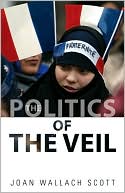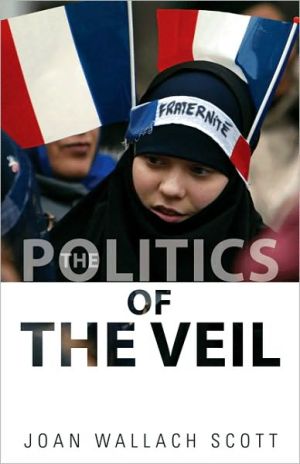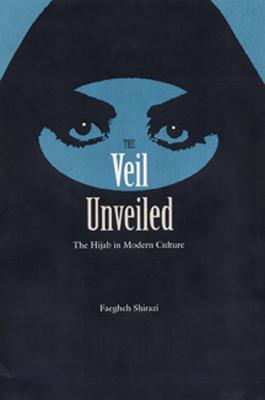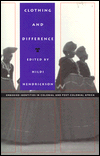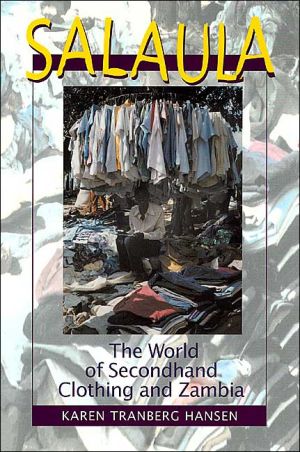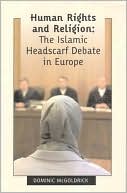Questioning the Veil: Open Letters to Muslim Women
Across much of the world today, Muslim women of all ages are increasingly choosing to wear the veil. Is this trend a sign of rising piety or a way of asserting Muslim pride? And does the veil really provide women freedom from sexual harassment? Written in the form of letters addressing all those interested in this issue, Questioning the Veil examines the inconsistent and inadequate reasons given for the veil, and points to the dangers and limitations of this highly questionable cultural...
Search in google:
"A wonderful read: well-written, well-constructed, well-argued, and highly significant. Lazreg addresses a controversial topic and takes intellectual risks. This little gem of a book is brilliant."--Sondra Hale, University of California, Los Angeles"Clearly expressed and convincing, this book makes arguments and counters opposing views in a subtle, gentle, and imaginative way. Readers will find the book fascinating and will be drawn to its personal nature and elegant answers."--Judith Herrin, King's College LondonJulia Droeber - Times Higher EducationMarnia Lazreg's discussion of the infamous piece of cloth, however, is different from most other treatises on the issue. It is personal and passionate. . . . As such, it is a highly relevant intervention into the debate on the veil.
Questioning the Veil\ Open Letters to Muslim Women \ \ By Marnia Lazreg \ Princeton University Press\ Copyright © 2009 Princeton University Press\ All right reserved.\ ISBN: 978-0-691-13818-3 \ \ \ Chapter One\ Modesty \ When I was a child, growing up in a colony, one day my maternal grandmother noticed two small swellings on my chest that slightly raised my blue silk dress. Concluding that I was becoming a woman, she said that it was time for me to wear the veil, the white piece of cotton or silk that women wore then in Algeria. My grandmother's argument struck me at the time for its bluntness. "A woman should hide her ugliness or her beauty. That's the way it should be. You must protect yourself!" she said, to my dismay.\ Veiling: A Bridge over Generations\ Forty years later, in 2003, Assia, a lower-middle-class, pretty young woman of twenty-two from a coastal city in western Algeria took up the hijab under pressure from colleagues and neighbors to "protect" herself. Assia aspired to a career as a singer but had worked as a clerk in a government office before she quit because of sexual harassment. To comply with the requirement of protection, or sutra (which in Arabic also means concealment), Assia, who had never worn a veil before, decided to follow a style of veiling (qashabiya) adapted from Moroccan women, composed of a long, coatlike dress-in fact a variant of a man's traditional jallaba-topped by a hood, but she let the hood hang over her shoulders and back. In this way Assia covered her body, concealing her full breasts (which nevertheless could still be made out), but leaving her hairless head and face bare. She had shaved her head because she did not like her curly hair, but I suspect that she wished to preserve her individuality, which had been erased by her long, wide veil.\ I thought of what my grandmother had said to me years ago and wondered what she would say today about Assia's veil. Assia was "covered" in the sense that no one could tell what she wore under her long coat or see the shape of her legs, but everyone could see her face and hair, or what was left of it. And this was acceptable to her neighbors, the vendors at the market, and the man on the street because she had complied with the new norm enjoining women to conceal their bodies.\ Assia is the daughter of Mina, sixty-eight, who now lives in the south of France. I interviewed Mina on a trip to France in the summer of 2007. Mina vividly remembers the day she had to begin wearing the local Algerian white veil, a square of cloth that is wrapped around the body, fastened at the waist to a belt, and pulled over the face so as to leave an opening for one eye. Algiers women refer to it derisively in colloquial Arabic as Bou 'Aouina, or the "Single-Eye." Mina was thirteen years old when her mother told her that it was time for her to be veiled, now that she was menstruating and her breasts were budding. Her brother, only three years older, had also remonstrated with their father that his sister was "looking like a woman" and should therefore be veiled as well as quit school. She remembers that her first veil was a bedsheet, which she had found upsetting: "Imagine! A bedsheet!" She could still recall feeling disoriented on the street when she took her first steps under her veil, which her mother had helped her to adjust. As she put it, "I did not feel good at all wearing the veil. I felt camouflaged. But then I thought this is life, you know?" She also felt "jealous" of the few girls who, because they lived in French neighborhoods in which they were less conspicuous, could afford not to wear the veil. Mina had been a beautiful young woman who worried about losing her looks under her veil. To allay her fear, she decided to make herself look good in her veil, to distinguish herself from the other veiled women. She bought expensive silk veils imported from Tunisia, which she wore over stiletto heels, and draped the silk over her face so as to make the opening for the eye larger. Her high heels guaranteed that her ankles would be exposed.\ I was moved by Mina's early memories of her veiling. She had experienced the veil as a turning point in her life, signaling not only confinement but loss of femininity: the world had closed in on her. Her mother loomed large in her description of the crucial day when she first wore the veil. The poignant strategies she used to retain her individuality and femininity speak to her resentment of veiling. She had been a vivacious girl, well liked by her friends, happy to run errands for her mother and play outdoors. She was also very tough, beating back boys who tried to tease girls in her neighborhood. The veil put an end to her life of youthful insouciance that knew no gender limitation. Had she been born outside the culture of the veil, she would have continued to enjoy going outside her home and lived out her adolescence and young adulthood at her own pace. She would have had no abrupt separation in her life; she would have continued to enjoy the freedom of running, feeling the wind through her hair, and just being alive like her brother. Instead, with the onset of her menses, the biological clock ticked for her at age thirteen, and the veil fell like a curtain on her childhood. Mina's wistful description of her interrupted childhood brought back to mind the countless prepubescent girls I have observed over the years in small towns or poor neighborhoods in large cities. They would be lively, joyful, but as soon as they reached an age when they were made to wear a hijab, they would lose the spark in their eyes and become more self-conscious and less spontaneous. I suspect that the veil makes them at once more aware of their changing body and of the social limitations that such change entails for them as girls.\ It was not until age twenty-two that Mina married. She spent her adolescence at home learning how to become a good housewife and fighting with her mother. On occasion when she traveled outside her city, she would take off her veil, being confident that no one would recognize her, and resume wearing it when it was time for her to return home. We seldom ask ourselves how the generations of women who wore veils felt about them. We cannot imagine them without their veils, as if they had been born with them; we expect them to wear them because they expected to wear them. Yet they experienced a more limited existence because of their veils.\ Mina never thought that Assia, born after the independence of Algeria from France, would wear a veil. Assia's brothers had not pressured her to take it up. Mina was aware, however, that since the 1990s the social climate in her birthplace had become more conservative and more restrictive for women. Both mother and daughter, three decades after the independence of Algeria, were now going out in a hijab. Mina, a retiree from a minor clerical job in public administration-where her daughter had also worked briefly-was able to secure a French visa, a first step toward applying for residency papers, and hoped that in good time she might be able to bring her daughter to France as well. It was not specifically the veiling trend that prompted her to leave Algeria, but a feeling that as an older woman (who looked younger than her years) and a widow, the quality of her life in a provincial city had diminished. The veil was one aspect of her changed circumstances. She had hoped that her daughter would not have to play the same masquerading games with the veil that she herself had played in her youth.\ The veil in this case symbolically bridges the gap that started to appear in the 1960s and 1970s in Middle Eastern societies between the older, less educated or uneducated women and their daughters, who were getting college degrees and entering the job market. Assia had had a better education than her mother, but she was now in a similar social situation, having to worry about her dress.\ Shifting Modesty\ It is customarily understood that modesty is a prime reason for wearing a veil. However, neither Mina nor Assia thought of her veil as a mark of modesty, although they both used the word sutra (protection) to explain their veiling in a somewhat perfunctory manner and with their eyebrows raised to convey doubt. Assia blamed her attire on the "bearded ones," meaning the men who in the last decade had grown beards to display their religiosity, many of whom had also joined the Islamist movement. What was it that Assia's body was protected and concealed from? Was it the long looks that men still gave her as she passed by, or was it her capacity to handle her own body? Could it be that if Assia did not conceal her body, she would not know how to dress it, would allow it to get the better of her, and would lose control of herself?\ Modesty is both a character trait and a manner of acting with others that is inconspicuous and unobtrusive. Not attracting attention to oneself, not sticking out in public, is an attribute of modest behavior, as is avoidance of ostentatious display of wealth. In and of itself, modesty is a good quality that connotes some consideration for others' feelings in dealing with them. But why is the veil a mark of modesty? Can a woman not dress modestly without wearing a long coat that flaps between her feet, picks up dirt on the ground, soaks up rain from puddles, and hinders her speed when she is in a hurry? What does it mean to be modest for a Muslim woman? How does a woman reconcile the modesty of the veil with the modesty of character? What if a woman is modest in her dress but immodest in her speech and actions? Conversely, would a woman who does not wear a veil but dresses conservatively and is modest in character be termed immodest?\ This discussion is hardly necessary since a key chapter (sura) in the Quran referring to dress does not mention "modesty," for which the Arabic word is istihsham. However, various translations have consistently used the concept "modest" to render the meaning of the expression "preserve [protect or guard] your pudenda [in Arabic furuj]." Similarly, the Arabic words khimar, referring to a piece of clothing, possibly a kerchief, worn by women in the seventh century, and jilbab, another garment that clothes the body, have been often translated as "veil." Since full details of how women dressed in the heroic period of Islam are not known with accuracy, the terms used for their clothing remain open to various interpretations, as does "modesty."\ And tell the believing women to lower their gaze and be modest, and to display of their adornment only that which is apparent, and to draw their veils over their bosoms and not to reveal their adornment save to their own husbands or fathers or husbands' fathers, or their sons or their husbands' sons, or their brothers' sons or sisters' sons, or their women or their slaves, or male attendants who lack vigor, or children who know naught of women's nakedness. And let them not stamp their feet so as to reveal what they hide of their adornment. And turn unto Allah together, O believers, in order that ye may succeed. (emphasis added)\ A more enlightened translation avoids the word "modesty" but introduces other uncertainties:\ Tell the believing women to lower their eyes, guard their private parts, and not display their charms except what is apparent outwardly, and cover their bosoms with their veils and not show their finery except to ... (emphasis added for comparison with previous translation)\ It is noteworthy that this sura does not enjoin a woman to cover her face. Furthermore, the sura recommends not displaying one's breasts and beauty (in Arabic zina, translated as "adornment" in the first text-a concept open to multiple definitions), or drawing attention to oneself by stamping one's feet, presumably to clank anklets-an obsolete custom. This last detail disappears entirely from the second translation and is replaced by "finery," an imprecise concept. In other words, in light of this sura, what passes for modesty-as-protection is a matter of opinion and choice of words instead of a clear religious obligation. Such translation uncertainties not only reveal shifts of meaning depending on what term is chosen, but also cast doubt on the routine use of such concepts as "modesty" in justifying veiling. Hence the late French historian Jacques Berque could accurately, if boldly, translate furuj as "sexe," which in French refers to sexual organs, and khimar as "shawls," instead of veils. His translation of the first part of the sura is worth reproducing as it illustrates shifts in meanings depending on language and quality of translation: "Tell the believing women to lower their gaze and contain their sex; not to show their adornments except that which appears, draw their shawls over the cleavages in their clothes" (emphasis added).\ Berque adequately interprets juyub, usually translated as breasts or bosoms, as meaning cleavage-a term that makes more sense considering that it is unlikely that women in the early days of Islam walked around with bare breasts. It is more reasonable to assume that some may have worn garments that reveal cleavage. Besides pudenda, bosoms, adornment, finery, and beauty all complicate the term "modesty," which becomes an umbrella concept for justifying veiling. Interestingly, men too are exhorted in the Quran to protect their pudenda (also translated as "modesty"). However, this exhortation has not given rise to multiple interpretations, nor has it been used to conflate dress with moral character, as has been the case with women. If one were to elide the uncertain and time-specific dress vocabulary and tell the story that emerges from two critical suras focused on women's bodily comportment, it would read as follows: women should dress in a way that does not expose their breasts and genitals or flaunt their natural beauty, so as not to draw attention to themselves and avoid harm.\ It is particularly confusing for a young Muslim girl to hear that modesty is the hallmark of being a Muslim woman, and that the only sign of modesty is not specific behavior and deeds, but the veil that a woman wears. In other words, modesty as a rationale for wearing a veil hangs on a concept that is so elastic as to be meaningless. Conceivably, a woman could dress any way she wishes as long as she does not display her breasts or wear makeup. Yet women wearing the hijab also use makeup, just as many non-Muslim women do not wear garments that show cleavage or put on makeup. A Muslim woman is not more modest than another woman for wearing a veil. Modesty is not reducible to the veil. Jamal ad-Din al-Afghani, the nineteenth-century Muslim reformer, defined modesty as an individual's restraint from evil deeds that is more effective than laws. In this sense, modesty is not a virtue that can be legislated.\ Anthropologists correctly point out that modesty in Middle Eastern societies refers to a whole array of ideas and practices, including modalities of covering the body partially or totally; character traits such as bashfulness, humility, diffidence, and shyness; and the system of beliefs and customs that embed gendered conceptions of sex, chastity, virginity, adultery, and the like. As a character trait, modesty implies that a person seeks to downplay her achievements or skills so as not to make others jealous or envious. Such a person would refrain from bragging about her accomplishments. She may also not seek praise or credit for her accomplishments, thereby indicating that she values what she has accomplished more than she does its social evaluation. At the heart of modesty so construed is also a certain degree of self-underestimation. Clearly the veil has little to do with a woman's accomplishment. It implies that a woman should humble, belittle, and feel sorry for her body-the locus of the self. At any rate, the function of the veil is at odds with its current meaning as a sign of modesty except in the narrow sense of not flaunting one's beauty. Yet a veil is not necessarily the best or only way for a woman to refrain from flaunting her beauty. Does the veil then represent only one aspect of modest behavior as understood in custom and not in the religious text, or does it sum up modesty comprehensively?\ (Continues...)\ \ \ \ \ Excerpted from Questioning the Veil by Marnia Lazreg Copyright © 2009 by Princeton University Press. Excerpted by permission.\ All rights reserved. No part of this excerpt may be reproduced or reprinted without permission in writing from the publisher.\ Excerpts are provided by Dial-A-Book Inc. solely for the personal use of visitors to this web site. \ \
Acknowledgments ix Introduction 1 Letter One: Modesty 15 Letter Two: Sexual Harassment 41 Letter Three: Cultural Identity 53 Letter Four: Conviction and Piety 67 Letter Five: Why Women Should Not Wear the Veil 97 Notes 133 References 147 Index 153
\ Charles Middleburgh blogQuestioning the Veil is an excellent examination of an extremely controversial and divisive piece of clothing, written with unimpeachable authority, and a valuable source of information for anyone seeking to achieve an informed perspective on the subject.\ — Rabbi Dr Charles H Middleburgh\ \ \ \ \ EconomistLong or short, sternly pinned or silkily draped, the Islamic veil is the most contentious religious symbol today, in the West as much as in the Muslim world. . . . [Lazreg] feels passionately that Muslim women should not wear the veil, as both her mother and grandmother obediently did. . . . [A] useful and timely counterpoint.\ \ \ Insight TurkeyRead as the author declares it to be, not a scholarly treatise, but a very personal inquiry, Marnia Lazreg's book is a rich and committed contribution to the current debate on the veil.\ — Irina Vainovski-Mihai\ \ \ \ \ Contemporary Islam[Lazreg's] strong, but sensitive, prose rescues the veil debate from theological disputation and overly footnoted treatises.\ — Daniel Martin Varisco\ \ \ \ \ Times Higher EducationMarnia Lazreg's discussion of the infamous piece of cloth, however, is different from most other treatises on the issue. It is personal and passionate. . . . As such, it is a highly relevant intervention into the debate on the veil.\ \ \ \ \ Charles Middleburgh blogQuestioning the Veil is an excellent examination of an extremely controversial and divisive piece of clothing, written with unimpeachable authority, and a valuable source of information for anyone seeking to achieve an informed perspective on the subject.\ \ \ \ \ Insight TurkeyRead as the author declares it to be, not a scholarly treatise, but a very personal inquiry, Marnia Lazreg's book is a rich and committed contribution to the current debate on the veil.\ \ \ \ \ Contemporary Islam[Lazreg's] strong, but sensitive, prose rescues the veil debate from theological disputation and overly footnoted treatises.\ \ \ \ \ Suomen Antropologi[I]t is good that such a book exists. Every woman should read it and reflect on it honestly before making up her mind about veiling.\ \ \ \ \ Charles Middleburgh blog\ Questioning the Veil is an excellent examination of an extremely controversial and divisive piece of clothing, written with unimpeachable authority, and a valuable source of information for anyone seeking to achieve an informed perspective on the subject.\ \ \ \ \ Rabbi, Doctor; Charles Middleburgh blogQuestioning the Veil is an excellent examination of an extremely controversial and divisive piece of clothing, written with unimpeachable authority, and a valuable source of information for anyone seeking to achieve an informed perspective on the subject.\ \ \ \ \ Times Higher EducationMarnia Lazreg's discussion of the infamous piece of cloth, however, is different from most other treatises on the issue. It is personal and passionate. . . . As such, it is a highly relevant intervention into the debate on the veil.\ — Julia Droeber\ \ \ \ \ ChoiceSociologist Lazreg, an authority on Algeria, has issued a call for frank and unmediated conversation among Muslim women. In a series of four letters that assert the major points of contention—modesty, sexual harassment, cultural identity, conviction, and piety—she lays bare the issues, apologetics, and real lives of veiled Muslim women in an unprecedented fashion. . . . A provocative text that demands a response.\ \

